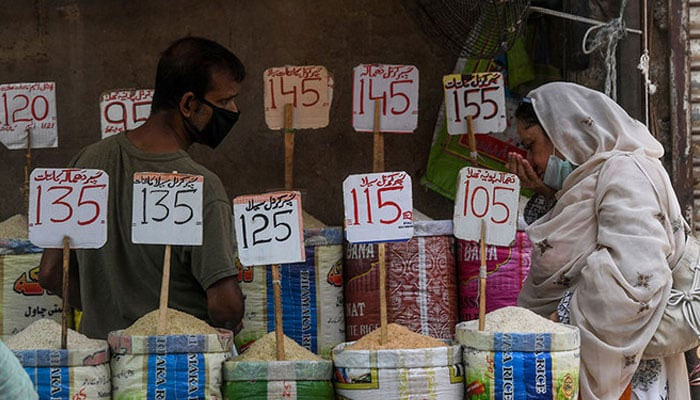Myopic policies, distorted prices
It would be a favour to Pakistan if our government stopped setting wheat and sugarcane prices
Microeconomics studies show how individuals choose to allocate various scarce resources. Another name for microeconomics is price theory, which tells us that prices play a vital role in efficiently allocating resources.
I start with this to emphasize that one important reason we are economically backward is because our government usually sets the wrong prices of things that it sells, distributes or influences -- and thus causes inefficiency and misallocation of resources in the economy.
In fact, almost all shortages (or excess capacity) of, say, gas and electricity, wheat and sugar, or cotton and sugarcane can be understood as a misallocation of resources due to wrong prices. Prices that are set due to political consideration and not based on sound economic principles.
Consider the recent accusation of corruption levelled by this government on its predecessor. It turns out that you can fully explain the recent wheat fiasco through wrong decisions by various governments based on political considerations.
The first culprit is the provincial and federal government’s decision in late 2022 to increase wheat purchase price from Rs2200 per maund (of 40 kg) to Rs3900 per maund. There was no economic justification for this decision; it was done only for political consideration. This of course meant a huge transfer from the urban poor to rural landowners.
Politicians also failed to think through the implications of this on the prices of flour and roti. If the governments are buying wheat for Rs100 a kg and selling for Rs115 per kg, of course the price of flour will increase to Rs130 per kg or thereabouts. In fact, due to unnecessary interprovincial and interdistrict restrictions on the movement of wheat, the price of flour had reached as high as Rs150 per kg in retail.
One simple fact my fellow politicians seem not to have grasped is that you cannot have expensive wheat and cheap flour.
The next mistake was that of the caretakers when they faced high prices of flour. They rightly facilitated the import of wheat but failed to put any limit on it. In the event, wheat was imported in Pakistan at around Rs90 per kg and very quickly we saw the price of wheat and flour come down. But at the same time, the Punjab government wasn’t able to sell its more expensive wheat, and nor was it willing to lose money. It was happy to subsidize farmers but only at the cost of consumers, not out of its own budget.
The third mistake was again late last year or early this year, when even though the international price of wheat had tumbled, the governments continued with the same high wheat buying price. In response to this price signal, farmers allocated more acreage to wheat and used expensive fertilizers to ensure a good wheat crop. And we ended up with a record wheat crop of over 31 million tons.
The final mistake here is again the government reneging on its promise to buy wheat at announced prices and farmers being left with huge stocks. The price of wheat is therefore in free fall and is around Rs70 per kg. On the flip side, the price of flour has also dropped to around Rs85 per kg and with it the price of roti.
So, we now have the spectacle of politicians congratulating themselves for bringing down the price of roti but blaming their predecessors for bringing down the price of wheat.
Let’s now consider electricity prices and the recent discussions on net metering. Our government sells electricity at a subsidized rate of Rs9 per unit to more than half the households that consume little electricity and sells power to richer households at over Rs40 per unit. At the same time, the government is allowing duty and sales tax-free import of solar panels that produce power for about Rs10 per unit. Moreover, the government allowed consumers to produce more power than they needed during the day and use the grid as a storage system through net metering.
Readers will know right away which category of customers will install solar panels and which will stay in the grid. As expected, the highest-paying customers shifted as much of their demand to solar panels as possible. But lower-income households getting subsidized electricity remained on the grid. This of course meant that the price of power would have to be raised even more on those remaining on the grid and buying at already higher rates. This is exactly what is happening. These difficulties are perpetuated because policies and prices are not right. When the government woke up to the implications of its policy, it tried to get out of the net metering contracts it had agreed to with consumers.
Consider too that all governments have bemoaned for years that we don’t grow enough cotton (which is a sensitive crop that can fail if the weather conditions turn adverse) and grow too much sugarcane which requires much more water.
But it never occurred to these governments that if they sold crop insurance to cotton farmers and made water dearer (to reflect the cost of water storage), the problem would be solved. But instead, governments make crop zones and restrict sugar production, in effect favouring existing mills in certain areas and creating more distortions.
Next consider that there was a time when the government used to subsidize industry through gas and electricity prices, creating a distortion. Now we have moved in the opposite direction and have priced energy to industry at a price much higher than the cost of production and above regional countries. This strategy too is wrong. We need to stop cross-subsidizing either industry or domestic consumers at each other’s expense. If a subsidy is warranted, as it is for poor consumers, it should come from the government’s budget -- not from price distortions. Otherwise, over the next few years, we will see industry leaving the grid and leaving only poor consumers behind.
We often see shortages of gas, electricity, water, etc, things that the government provides. But we are able to buy the latest mobile phone or computer or other such things that the market provides. The reason is that markets work on price incentives and profit motives. This is why we need to decrease the footprint of the government wherever possible.
I am a believer in direct income transfers and believe we should raise income transfer under BISP to one per cent of GDP or Rs1100 billion, from the current Rs400 billion. Beyond that, we should try to let the prices reflect true costs wherever possible. When necessary, subsidies should be structured such that we avoid huge distortions.
An area of success over the years is our rice exports, with exports annually expected to be over $3 billion -- a record. The reason: many years ago, the government very kindly decided to not help rice farmers and exporters and left them to the vagaries of the market. Since then the rice farmers, consumers, and exporters have done very well.
It would be a favour to Pakistan if our government stopped setting wheat and sugarcane prices.
The writer is an economist and a politician. He tweets/posts @Miftahismail
-
 Queens Mother Arrested After Abducting Child From Court-ordered Visit
Queens Mother Arrested After Abducting Child From Court-ordered Visit -
 Sarah Ferguson Ready To ‘spread Her Wings’ After Separating From ‘disgraced’ Andrew
Sarah Ferguson Ready To ‘spread Her Wings’ After Separating From ‘disgraced’ Andrew -
 Finn Wolfhard Shares How Industry Views Him Post 'Stranger Things'
Finn Wolfhard Shares How Industry Views Him Post 'Stranger Things' -
 Dylan O'Brien Gets Nostalgic After Reunion With Old Friend
Dylan O'Brien Gets Nostalgic After Reunion With Old Friend -
 UK Doctors Warn Screen Time Is Harming Children’s Health
UK Doctors Warn Screen Time Is Harming Children’s Health -
 Meghan Markle To Get Police Protection In UK If Travelling With Archie, Lilibet
Meghan Markle To Get Police Protection In UK If Travelling With Archie, Lilibet -
 Spencer Pratt Expresses Hope For Taylor Swift, Travis Kelce's Wedding Invite
Spencer Pratt Expresses Hope For Taylor Swift, Travis Kelce's Wedding Invite -
 Evan Peters Makes Unexpected Confession About 'American Horror Story' Season 13
Evan Peters Makes Unexpected Confession About 'American Horror Story' Season 13 -
 Kentucky Grandmother Arrested After Toddlers With Broken Skulls, Ribs
Kentucky Grandmother Arrested After Toddlers With Broken Skulls, Ribs -
 European Space Agency Hit By Cyberattack, Hundreds Of GBs Data Leaked
European Space Agency Hit By Cyberattack, Hundreds Of GBs Data Leaked -
 Elon Musk’s XAI Launches World’s First Gigawatt AI Supercluster To Rival OpenAI And Anthropic
Elon Musk’s XAI Launches World’s First Gigawatt AI Supercluster To Rival OpenAI And Anthropic -
 Google Adds On-device AI Scam Detection To Chrome
Google Adds On-device AI Scam Detection To Chrome -
 First Ocean Robot Launched To Monitor 'Category 5' Hurricanes
First Ocean Robot Launched To Monitor 'Category 5' Hurricanes -
 Gwyneth Paltrow Gets Honest About Filming Intimate Scenes With Timothee Chalamet
Gwyneth Paltrow Gets Honest About Filming Intimate Scenes With Timothee Chalamet -
 Duke's Peace Talks With King Charles, Prince William: 'Ball Is In Harry's Court'
Duke's Peace Talks With King Charles, Prince William: 'Ball Is In Harry's Court' -
 New Research Finds Back Pain May Disrupt Men’s Sleep Quality Later In Life
New Research Finds Back Pain May Disrupt Men’s Sleep Quality Later In Life




